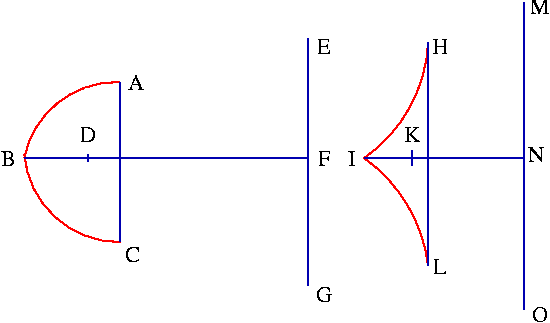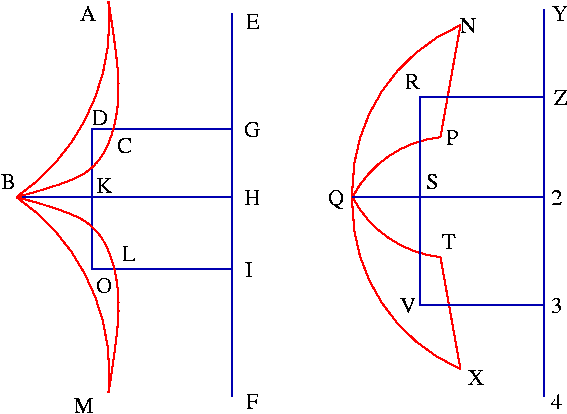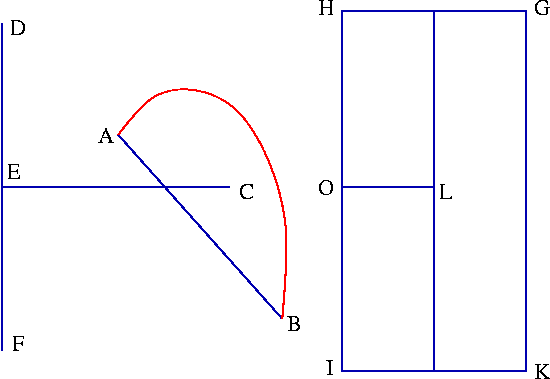- About MAA
- Membership
- MAA Publications
- Periodicals
- Blogs
- MAA Book Series
- MAA Press (an imprint of the AMS)
- MAA Notes
- MAA Reviews
- Mathematical Communication
- Information for Libraries
- Author Resources
- Advertise with MAA
- Meetings
- Competitions
- Programs
- Communities
- MAA Sections
- SIGMAA
- MAA Connect
- Students
- MAA Awards
- Awards Booklets
- Writing Awards
- Teaching Awards
- Service Awards
- Research Awards
- Lecture Awards
- Putnam Competition Individual and Team Winners
- D. E. Shaw Group AMC 8 Awards & Certificates
- Maryam Mirzakhani AMC 10 A Awards & Certificates
- Two Sigma AMC 10 B Awards & Certificates
- Jane Street AMC 12 A Awards & Certificates
- Akamai AMC 12 B Awards & Certificates
- High School Teachers
- News
You are here
James Gregory and the Pappus-Guldin Theorem - Selections from the GPU (2)
Proposition Thirty-one.
If there are two figures symmetric around an axis which are rotated in such a way that the axes of rotation of each of the figures are normal to the axis of each figure, then the ratio of one solid arising from such a rotation to the other solid arising from the same rotation is compounded directly from the ratio of the first figure to the other figure and from the ratio of the segment between the center of gravity and the axis of rotation of the first figure to the similar segment of the other figure.
Let ABC and HIL be any two figures symmetric around the axes BF and IN, which are rotated around the lines EG and MO cutting the extended (if necessary) axes BF and IN normally at the points F and N. Let D and K be the centers of gravity of the figures ABC and HIL. I say that the ratio of the solid arising from the figure ABC rotated around the line EG to the solid arising from the figure HIL rotating around the line MO, is compounded from the ratio of the figure ABC to the figure HIL and from the ratio of DF to KN.
Above the figures ABC and HIL let right cylindrical figures of equal height be cut by planes passing through the lines EG and MO, each one into two trunks, namely, an upper and a lower trunk. The ratio of the solid of revolution arising from ABC to the solid of revolution arising from HIL is compounded from the ratio of the lower trunk of the cylinder above ABC to the lower trunk of the cylinder above HIL and from the ratio of the radius of rotation of the figure ABC to the radius of rotation of the figure HIL.

But the lower trunk of the cylinder above ABC is to the lower trunk of the cylinder above HIL is in a ratio compounded from the ratio of the lower trunk of the cylinder above ABC to the entire cylinder above ABC, from the ratio of the entire cylinder above ABC to the entire cylinder above HIL, and from the ratio of the entire cylinder above HIL to its lower trunk. But from the convertendo of the Consequence to Proposition 29 the lower trunk of the cylinder above ABC is to the entire cylinder as FD is to the radius of rotation of the figure AB. Also, the cylinder above ABC is to the cylinder above HIL as the figure ABC is to the figure HIL. Similarly, by the Consequence to Proposition 29, the cylinder above HIL is to its own lower trunk as the radius of rotation of the figure HIL is to KN. Consequently, the ratio of the lower trunk of the cylinder above ABC to the lower trunk of the cylinder above HIL is compounded from the ratio of the line DF to the radius of rotation of the figure ABC, from the ratio of the figure ABC to the figure HIL, and from the ratio of the radius of rotation of the figure HIL to the line KN. Therefore, the ratio of the solid arising from the rotation of the figure ABC to the solid arising from the rotation of the figure HIL is compounded from the ratio of the figure ABC to the figure HIL, from the ratio of the line DF to the radius of rotation of the figure ABC, from the ratio of the radius of rotation of the figure ABC to the radius of rotation of the figure HIL, and from the ratio of the radius of rotation of the figure HIL to the line KN. But the last three ratios compound to the ratio of DF to KN. Therefore, the ratio of the solid arising from the rotation of the figure ABC around EG to the solid arising from the rotation of the figure HIL around MO is compounded from the ratio of the figure ABC to the figure HIL and from the ratio of the segment between the center of gravity of the figure ABC and its axis of rotation -- namely, DF -- to the segment between the center of gravity of the figure HIL and that same axis of rotation -- namely, KN -- which ought to have been demonstrated.
Proposition Thirty-three.
If there are any two figures which are rotated around a given axis, the ratio of the one solid arising from such a rotation to the other solid arising from the same rotation will be compounded from the direct ratio of one figure to the other figure and from the direct ratio of the segment between the center of gravity and the axis of rotation of the one figure to the similar segment of the other figure.
Let ABC and NQP be any two figures which are rotated around the lines EF and Y4, and let their centers of gravity be D and R, which are sent down lines DG and RZ perpendicular to the axes of rotation EF and Y4. I say that the ratio of the solid arising from the figure ABC rotated around the line EF to the solid arising from the figure NQP rotated around the line Y4 is compounded from the ratio of the figure ABC to the figure NQP and from the ratio of DG to RZ.
Let the lines BH and Q2 touching the figures ABC and NQP at B and Q be drawn parallel to the lines DG and RZ. Let the figures ABC and QNP be conceived to be revolved around the lines BH and Q2, like axes, until, attaining the plane on the other part of the axes, they make the figures BLM and QTX, equal and similar to themselves and having exactly the same position toward the lines BH and EF, and Q2 and Y4. Let O and V be the centers of gravity of the figures BLM and QTX. Let the lines OI and V3 be drawn perpendicular to the lines EF and Y4. Also, let the lines DO and RV, intersecting the lines BH and Q2 in the points K and S, be joined.

It is manifest that the point K is the center of gravity of the figure BACBLM symmetric around the axis BH and likewise that the point S is the center of gravity of the entire figure QNPQTX around the axis Q2. It is also apparent that the line DG, KH, OI and also RZ, S2, V3, are equal among themselves. Since the figures BACBLM and QNPQTX are symmetric around the axes BH and Q2, which are normal to the axis of rotation, therefore the solid of revolution arising from the rotation of the figure BACBLM around the line EF is to the solid of revolution arising from the rotation of the figure QNPQTX in the ratio compounded from the ratio of the figure BACBLM to the figure QNPQTX and from the ratio of KH to S2 by Proposition 31. But the solid arising from the figure BACBLM rotated around EF is twice the solid arising from the figure BAC rotated around the same EF. Likewise, the solid arising from the figure QNPQTX rotated around the line Y4 is twice the solid arising from the figure QNP rotated around the same Y4. Also, the figure BACBLM is twice the figure BAC and the figure QNPQTX is twice the figure QNP. Since halves are in the same ratio with their own doubles, the solid of revolution arising from the figure ABC rotated around the line EF will be to the solid of revolution arising from the figure NQP rotated around the line Y4 in the ratio compounded from the ratio of the figure ABC to the figure NQP and from the ratio of KH to S2--or DG to RZ--which it was desired to demonstrate.
Consequence.
It follows that if the centers of gravity of the figures are equally distant from the axes of rotation, the solids of revolution arising from the rotation of figures are in a direct ratio to the figures themselves. If the figures themselves are equal, it follows that the solids of revolution arising from their rotation are in a direct ratio to the segments between the centers of gravity and the axes of rotation. If the segments and figures are equal, the solids of revolution arising from them will be equal even if the figures are dissimilar between themselves.
Scholium.
From these results, it is manifest that between any two figures there are three ratios--namely, of the one figure to the other figure, of the solid of revolution arising from the rotation of one figure to the solid of revolution arising from the rotation of the other figure, and of the segment between the center of gravity and the axis of rotation of the one figure to the similar segment of the second figure--giving two of which always discloses the unknown third.
All these things are demonstrated universally In the same manner for every curve or curves not enclosing a figure thus so of all geometrical demonstrations these are maximally universal.
Proposition Thirty-five.
Each solid of revolution is equal to a right cylindrical figure whose base is the figure out of the rotation of which the solid is produced and whose altitude is the circumference of a circle in which the center of gravity of the figure is revolved.
Let AB be a figure whose center of gravity is C. Let a solid of revolution be made from the rotation of the figure AB around the line DF. I say this solid of revolution is equal to the cylinder whose base is the figure AB and whose altitude is the circumference of the circle in which the center of gravity C is revolved.
Let HGKI be a rectangle whose center of gravity is L.

Let a cylinder be conceived from the rotation of the rectangle HGKI around the side HI. From the centers of gravity C and L let perpendicular lines CE and LO, which are the radii of rotation, be sent down to the axes of rotation DF and HI. It is manifest that the cylinder arising from the rotation of the rectangle HK around HI is equal to the solid whose base is a circle with radius IK and whose altitude is HI -- that is, to the solid whose base is the rectangle on IK and the semicircumference of the circle with radius IK, or the entire circumference of the circle with radius OL, and the altitude HI. This is the same as the solid whose base is the rectangle HK and whose altitude is the circumference of the circle on the radius OL. But the cylinder from the rotation of HK around HI is to the solid of revolution from the rotation of AB around DF in a ratio compounded from the proportion of the figure HK to the figure AB and from the line OL to the line EC -- or the circumference on the radius OL to the circumference on the radius EC. (See Proposition 33.) But the solid whose base is HK and whose altitude is the circumference on the radius OL -- or the cylinder generated by the rotation of the figure HK around HI -- is in the same ratio to the solid whose base is AB and whose altitude is the circumference of the radius EC. Therefore, the cylinder from the rotation of the figure HK around HI is to the solid of revolution from the rotation of the figure AB around DF as the same cylinder is to the solid whose base is AB and whose altitude is the circumference of the circle on the radius EC. Consequently, the solid of revolution from the rotation of the figure AB around DF is equal to the cylinder whose base is AB and whose altitude is the circumference of the radius EC, which it was desired to demonstrate.
Andrew Leahy (Knox College), "James Gregory and the Pappus-Guldin Theorem - Selections from the GPU (2)," Convergence (February 2010), DOI:10.4169/loci003262




